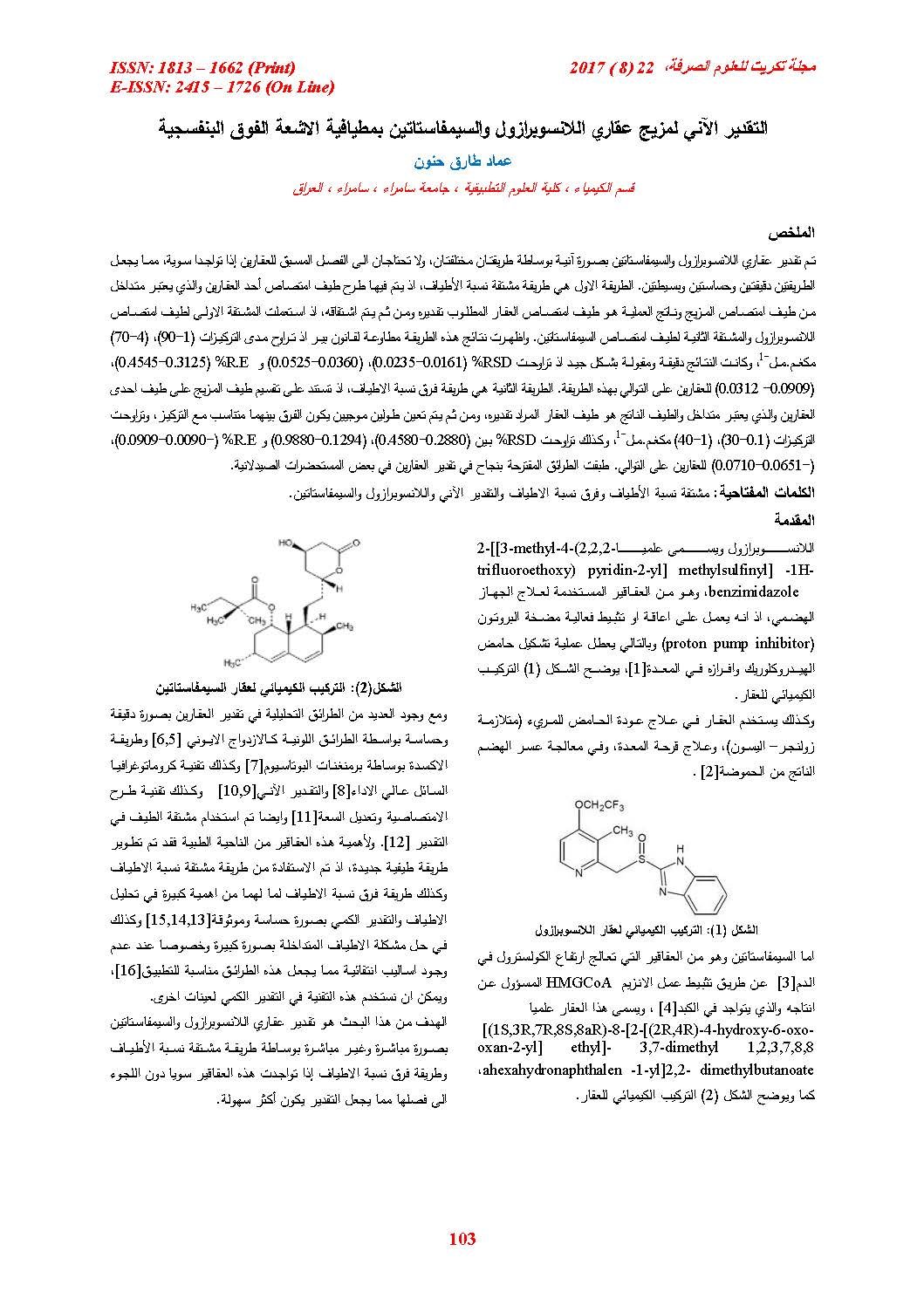Simultaneous Determination for Lansoprazole and Simvastatin drugs via Ultraviolet Spectrophotometry
Main Article Content
Abstract
A semi-novel, accurate, sensitive, simple, requiring no prior separation and economical procedures have been developed for the simultaneous analysis of binary mixture of Lansoprazole (Lanso) and Simvastatin (Semva). The first method is the Derivative of ratio spectra, in which the absorption spectrum of one drug as interfering drug were subtracted from the absorption spectrum of the mixture and then the net spectrum derivative, the first derivative (for Lanso) and second derivative (for Semva). Beer’s law was obeyed in the concentration ranges of (1-90) and (4-70) μg.ml-1 and the results showed that the method was precise and accurate with RSD% of (0.0161-0.0235), (0.0360-0.0525) and R.E% (0.3125-0.4545), (-0.0909-0.0312) for Lanso and Semva respectively. The second method based on ratio difference, where the absorption spectrum of mixtures the drugs was divided by the on the absorption spectrum of a suitable the interfering drug. The difference in peak amplitudes between the two selected wavelengths in the ratio spectra were recorded for each drug. Beer’s law was obeyed in the concentration ranges of (0.1-30) and (1-40) μg.ml-1 and the results of the method were precise and accurate with RSD% of (0.2880-0.4580), (0.1294-0.9880) and R.E% of (-0.0090-0.0909), (-0.0651-0.0710) for Lanso and Semva respectively of this method.
The proposed methods were successfully applied for the determination of the two compounds.
Article Details

This work is licensed under a Creative Commons Attribution 4.0 International License.
Tikrit Journal of Pure Science is licensed under the Creative Commons Attribution 4.0 International License, which allows users to copy, create extracts, abstracts, and new works from the article, alter and revise the article, and make commercial use of the article (including reuse and/or resale of the article by commercial entities), provided the user gives appropriate credit (with a link to the formal publication through the relevant DOI), provides a link to the license, indicates if changes were made, and the licensor is not represented as endorsing the use made of the work. The authors hold the copyright for their published work on the Tikrit J. Pure Sci. website, while Tikrit J. Pure Sci. is responsible for appreciate citation of their work, which is released under CC-BY-4.0, enabling the unrestricted use, distribution, and reproduction of an article in any medium, provided that the original work is properly cited.
References
1- Current Index of Medical Specialities (CIMS),
CMP Medica India Pvt Ltd, Bangalore, India, 2005,
72.
2- K. Basavaiah, V. Ramakrishna, U.R. Anil kumar1
and B.C. Somashekar, Ecl. Quím, São Paulo, 32(1):
2007, 57-64.
3- E. Leitersdorf, Int. J. Clin Pract. 56 Suppl 2:
2002, 116-9.
4- M. Heek, C. Farley and D. Compton, J.
Pharmacol, 134: 2001, 409-17.
5- C. Bala Sekharan1, M. Prasada Rao, Sk.
Naseema, G. Suresh Kumar and B. Alekhya, App.
Sci. Report, 10(2): 2015, 105-11.
6- I, Rizwana1, K. Prakash and G. Mohan, Chem Sci
Trans, 3(4), 2014, 1390-95.
7- O. Devi, K. Basavaiah, K. Vinay, Journal of Saudi
Chemical Society,17: 2013, 387–96.
8- R. Kachave, M. Kale and R. Wagh,, The Open
Analytical Chemistry Journal, 8: 2015, 7-11.
9- N. Choudhary, I. Siddiqui, J. Rai, S. Singh, S.
Surabhi and H. Gautam, Der Pharma Chemica, 5(2):
2013, 67-74.
10- H. Lotfy, Int J Pharm Pharm Sci, Vol 4 Suppl 4:
2012, 673-79.
11- H. Lotfy, Int J Pharm Pharm Sci, 6(1): 2014, 735-
41.
12- S. Abdel-Naby and Z. Abdelaziz, European
Journal of Chemistry, 3(4): 2012.
13- H. Lotfy and M, Hegazy, Spectrochimica Acta
Part A: Molecular and Biomolecular Spectroscopy,
113: 2013, 107–114.
14- H. Lotfy, M. Hegazy and A. Abdel-Gawad,
European Journal of Chemistry, 4(4): 2013.
15- N. Magdy and M. Ayad, Spectrochimica Acta
Part A: Molecular and Biomolecular Spectra, 137:
2015, 685–91.
16- A. Sayed and M. Khalil, Talanta, 43(4): 1996,
583.
17- D. Dogrukol - Ak, M. Tuncel, H. Aboul - Enein,
Short Communication Column Liquid
Chromatography Chromatographia, 54(7): 2001, 527-
30.
18- A. Munir, M. Ahmad, M. Zubair and M. Minhas,
rop J Pharm Res, 13(1): 2014, 135-39.
19- S. Silva, G. Rezende and V. Borall, Braz. J.
Pharm. Scim, 50(3): 2014.
